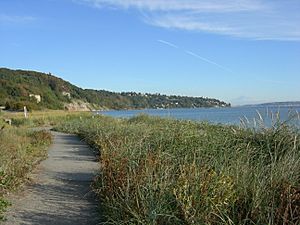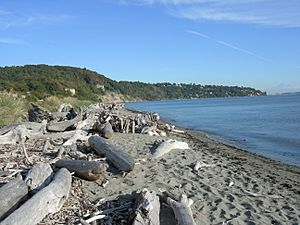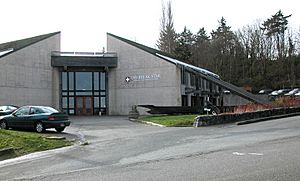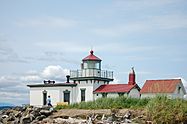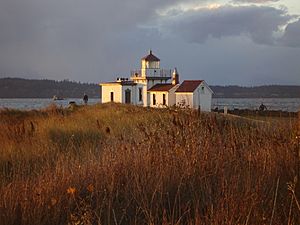Discovery Park (Seattle) facts for kids
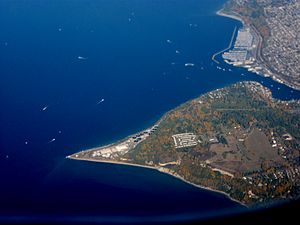
Discovery Park is a huge park in Seattle, Washington. It covers about 534 acres (2.16 square kilometers) right on the shores of Puget Sound. This makes it the biggest public park in Seattle!
The park has over 11 miles (19 kilometers) of walking trails. You can find the United Indians of All Tribes' Daybreak Star Cultural Center inside the park. There's also a cool lighthouse at West Point, which is the westernmost tip of Seattle.
A special path called the Discovery Park Loop Trail is 2.8 miles (4.5 kilometers) long. It was named a National Recreation Trail in 1975. This trail connects to many other paths throughout the park.
Discovery Park was built on the land of an old military base called Fort Lawton. Most of the historic Fort Lawton area is now part of the park. Both the Fort Lawton Historic District and the West Point Lighthouse are listed on the National Register of Historic Places, meaning they are important historical sites.
The park's landscape is full of different natural areas. You can explore forests, sandy beaches, open prairies, and tall bluffs.
Discovering Nature at Discovery Park
Discovery Park is one of the best places in Seattle to see amazing wildlife. You can spot many different kinds of birds and marine animals here. The Seattle Audubon Society has even listed 270 types of birds seen in the park!
In the waters of Elliott and Shilshole Bays, you might see harbor seals and California sea lions. The wooded areas of the park are home to cute Townsend's chipmunks.
Many visitors love hiking the Loop Trail. This trail goes through forests, open meadows, and bushy areas. It offers fantastic views of Puget Sound.
You can reach the shoreline by road or by trail. The hike back up from the north beach can be a bit of a workout! If you want to drive to the beach, you need a special permit. These free permits are for groups with young children (7 and under), seniors (62+), and people with physical disabilities. You can get them at the Environmental Learning Center.
The park has many types of trees. You'll find Bigleaf maples, Red alders, Bitter cherry trees, Douglas firs, western red cedars, and Western hemlocks. Some plants like Himalayan blackberry and English ivy are also present. Park staff work hard to manage these plants so the native ones can thrive.
A Look Back: Discovery Park's History
Discovery Park is quite new compared to some other parks. It was created in the early 1970s. The land used to be part of Fort Lawton, a military base for the U.S. Army.
The city gave the land for the fort to the Army in 1898, and Fort Lawton opened in 1900. In 1938, the Army even offered to sell the land back to the city for just one dollar! But the city said no because they were worried about how much it would cost to take care of it.
Most of the land was given to the city in 1972. It officially became Discovery Park in 1973. Fort Lawton continued to be an Army Reserve facility until it finally closed in 2012.
Did you know that the famous grunge band Temple of the Dog filmed the music video for their song "Hunger Strike" right on the shores of Discovery Park?
Challenges and Wildlife Encounters
One important topic for Discovery Park has been what to do with the old military buildings and land. In 2004, Seattle decided to buy 24 acres of U.S. Navy property within the park. The plan was to remove the old buildings to create more open green space for everyone to enjoy.
Later, when the Army base Fort Lawton was closing, there were many discussions. Some people wanted to build affordable housing on the land. Others in the neighborhood preferred to keep it as open space. City leaders approved plans for some housing units, and government agencies like the U.S. Department of Housing and Urban Development (HUD) also suggested using parts of the land for housing.
Discovery Park is also known for attracting wild animals! In the winter of 2008-2009, a coyote living in the park made the news. In May 2009, a black bear was seen. And in September 2009, the park was even closed for a short time because a cougar was spotted! The cougar was safely caught and moved to the Cascade mountains.


